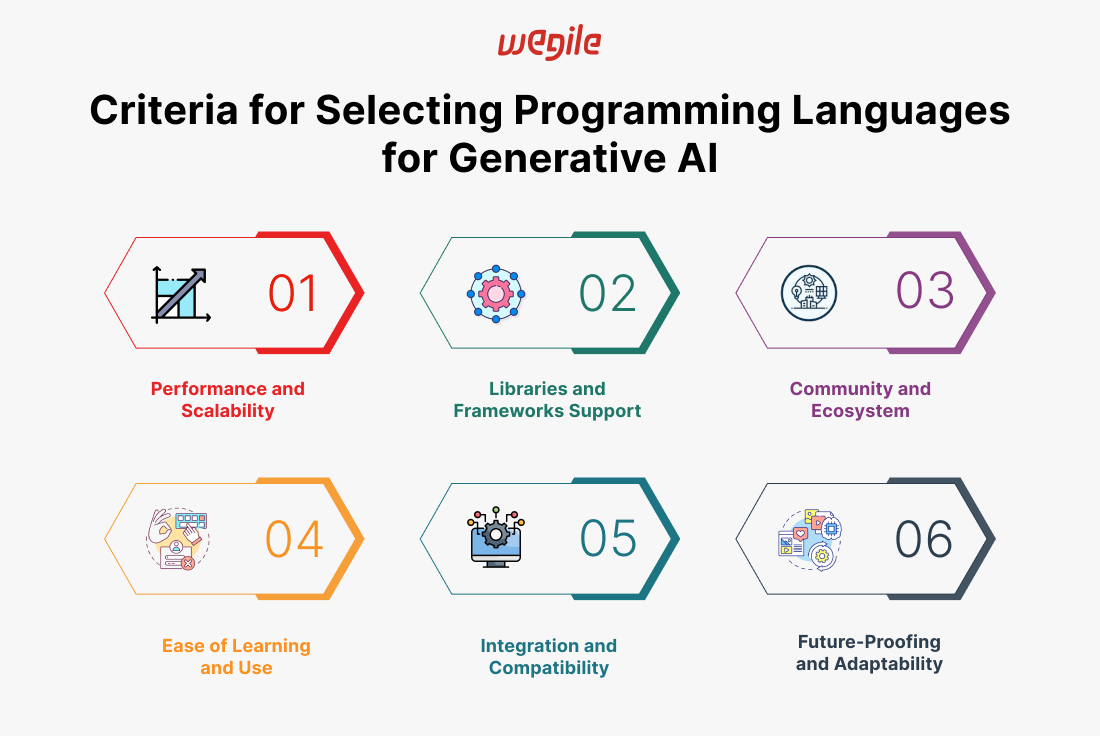Generative AI has surged in popularity, revolutionizing how we create content and solve complex problems. From generating realistic images and text to designing software and simulating scientific phenomena, generative AI is being leveraged in the real world for various use cases. Industries such as healthcare, finance, entertainment, travel, marketing, real estate, etc, are harnessing their capabilities to innovate and stay competitive. Businesses are building generative AI solutions to automate tasks, enhance creativity, and derive insights from vast datasets. As companies dive into the world of generative AI, one of the critical decisions they face is choosing the right programming language. This choice impacts the development speed, performance, and scalability of their AI applications. With numerous options available, selecting the best language can be challenging. But there's no need to worry. In this article, we've covered the top five programming languages for generative AI in 2024. Whether you're an investor or an AI enthusiast, this guide will help you navigate the choices and find the best fit for your generative AI projects.

Choosing the right programming language for generative AI development is more than just picking a popular option. It involves a detailed analysis of several critical criteria to ensure the selected language aligns with the project's needs. Understanding these criteria can help in making an informed decision that boosts efficiency and effectiveness.
Performance and scalability are paramount in generative AI, where models can be computationally intensive and large datasets. High-performance languages like C++ and Julia offer significant advantages by allowing for fine-grained control over system resources and optimizing execution speed. These capabilities are especially important in real-time applications and large-scale deployments where every millisecond counts.
The availability of robust libraries and frameworks can dramatically reduce development time and enhance functionality. Python, with its extensive ecosystem of libraries like TensorFlow, PyTorch, and Keras, provides powerful tools that streamline the development of generative AI models. Meanwhile, JavaScript's TensorFlow.js enables machine learning models to run directly in the browser, expanding the possibilities for web-based applications.
Must Read: Top Generative AI Tools By Use CaseAn active community and a rich ecosystem are invaluable for overcoming challenges and accelerating development. A language with a strong community offers extensive documentation, shared code repositories, and regular updates. Python and JavaScript are prime examples of languages with vibrant communities that contribute to a wealth of resources, ensuring developers can find solutions and support quickly.
The learning curve of a programming language can influence its adoption, especially among beginners and interdisciplinary teams. Python is known for its readability and simplicity, making it accessible to a wide range of developers. On the other hand, languages like Julia, designed with mathematical and scientific computing in mind, provide a syntax that is both high-level and expressive, reducing the complexity of coding for advanced applications.
Generative AI applications often need to integrate with other systems, databases, and technologies. Languages that offer seamless integration capabilities can simplify these processes. R, for instance, excels in statistical analysis and data visualization, making it ideal for data-driven AI projects that require extensive data handling and manipulation. Ensuring compatibility with existing infrastructure and tools is crucial for smooth operations and scalability.
The tech landscape evolves rapidly, and choosing a language that can adapt to future developments is essential. Emerging languages like Julia are built with future needs in mind, offering performance improvements and modern features that cater to the evolving demands of AI development. Keeping an eye on the language's development roadmap and industry adoption trends can provide insights into its long-term viability.
Python remains a dominant force in the realm of generative AI thanks to its versatility, simplicity, and extensive ecosystem. Its popularity is due to its ease of use and the powerful libraries and frameworks that support complex AI development. Python's rise in popularity can be attributed to its readability and straightforward syntax, which makes it accessible to both beginners and experienced developers. It is widely adopted in academia and industry alike, creating a vast pool of resources and community support. Python's design philosophy emphasizes code readability and simplicity, enabling developers to focus more on solving problems rather than wrestling with complex syntax.
Extensive Libraries and Frameworks: Python boasts powerful libraries like TensorFlow, PyTorch, and Keras, which simplify the development of complex AI models.
Ease of Use and Readability: Python’s syntax is straightforward and readable, making it accessible to beginners and allowing developers to focus more on solving problems.
Large Community and Support: An active and large community provides extensive documentation, tutorials, and support, accelerating problem-solving and development.
Versatility: Python can be used for a wide range of applications beyond AI, including web development, data analysis, and automation, making it a versatile choice for developers.
Error Handling: Python's built-in error handling mechanisms can help catch and address issues during development. However, for robust generative models, developers might need to implement additional error handling specific to the AI tasks.
Dependency Management: Managing dependencies between various Python libraries can become complex in large projects. This can introduce potential reliability issues if version conflicts arise. Using tools like virtual environments helps mitigate these issues.
JavaScript, traditionally known for web development, has emerged as a powerful language for generative AI, especially with the advent of Node.js. Its ability to run on both the server and client-side makes it a unique tool in the AI developer's toolkit. JavaScript’s versatility stems from its ubiquity in web development and its ability to execute in any modern web browser. This capability makes it ideal for deploying AI models directly to users without the need for complex backend infrastructure. With Node.js, JavaScript extends its reach to server-side applications, enabling developers to create full-stack AI solutions using a single language.
Active and Supportive Community: JavaScript boasts a large and active community. This translates to a wealth of resources, tools, and ongoing support for developers building generative AI models with JavaScript. The community fosters continuous improvement of libraries and frameworks, contributing to the overall reliability of the JavaScript ecosystem for generative AI.
Real-Time Deployment and Interaction: Libraries like TensorFlow.js enable the building and running of generative models directly in the browser. This facilitates faster deployment and real-time interaction for web-based AI applications, which is ideal for projects where users need to interact with the generative model in real-time.
Streamlined Development with Node.js: Node.js allows developers to use JavaScript for both front-end and back-end development of generative AI applications. This simplifies the development process by reducing context switching between languages, which can lead to fewer errors.
Library Maturity: While JavaScript has libraries like TensorFlow.js and Brain.js, they might be an evolving field compared to established libraries in other languages. This can mean fewer resources for testing and debugging, potentially impacting the reliability of complex generative models. For complex AI projects, it's important to assess the maturity of available JavaScript libraries and their suitability for the task.
Performance Limitations: JavaScript has improved in performance, but computationally intensive generative models might encounter limitations. If your project requires high-performance AI tasks, it's important to explore alternative approaches within the JavaScript ecosystem or consider other languages.
R is renowned for its powerful statistical and data analysis capabilities, making it a valuable language for generative AI, especially in data-driven projects. R excels in statistical computing and graphics, which makes it an excellent choice for projects that require extensive data manipulation and visualization. Its vast library of statistical tools and functions allows for sophisticated data analysis, a crucial aspect of many generative AI applications. R's syntax and data handling capabilities are designed specifically for statistical tasks, providing a robust foundation for developing AI models that rely heavily on data analysis.
Strong Data Foundations: R excels in handling and manipulating large datasets. This is crucial for training reliable generative models, as high-quality data is essential for accurate outputs. R's capabilities ensure the model is trained on clean and accurate data, leading to more reliable results.
Specialized Toolset: R offers a rich ecosystem of packages specifically designed for machine learning and deep learning tasks in generative AI. Packages like caret, mlr, and tensorflow provide well-established tools for various aspects of model building. These well-tested and refined packages contribute to the overall reliability of the development process.
Active Community Support: A vibrant R community fosters knowledge sharing and collaboration. This translates to readily available resources, troubleshooting assistance, and code optimization techniques. By leveraging this community, developers can identify and address potential issues before they impact model reliability.
Comprehensive Documentation: R boasts extensive documentation that covers not only the base language but also its many packages. This documentation provides developers with clear guidance on using R's functionalities for generative AI development. Clear instructions help developers avoid errors and ensure reliable implementation of their models.
Julia is an emerging language in generative AI, known for its high-performance capabilities and ease of use for scientific computing. Julia stands out due to its impressive performance. It is designed to handle high-performance numerical and scientific computing, making it an excellent choice for generative AI tasks that require intensive computation. Julia's syntax is straightforward and user-friendly, but it includes features that cater to high-level mathematical operations and algorithmic efficiency.
High-Performance Computing Power: Julia excels at computationally intensive tasks, similar to languages known for performance. This translates to reliable model training and execution, especially for complex generative models with large datasets. Developers can be confident that Julia can handle the demands of their AI projects.
Clear and Maintainable Codebase: Julia's syntax is designed to be user-friendly and readable. This clarity helps reduce errors during development and simplifies code maintenance in the long run. Clear code leads to more reliable models as potential issues are easier to identify and fix.
Advanced Generative AI Ecosystem: A growing ecosystem of Julia libraries caters specifically to generative AI development. Flux.jl provides a powerful framework for building neural networks, while Turing.jl offers tools for probabilistic programming, a crucial area in generative AI. These libraries are actively maintained by the Julia community, ensuring ongoing reliability through bug fixes and improvements.
Flexibility through Interoperability: Julia seamlessly integrates with other programming languages. This allows developers to leverage existing, well-tested codebases and tools written in different languages. By incorporating these external resources, developers can enhance the project's reliability by utilizing code with a proven track record.
C++ is a well-established language known for its performance efficiency and control over system resources, making it a solid choice for performance-critical generative AI applications. C++ offers unparalleled efficiency and low-level memory management, which are crucial for applications requiring high performance and resource optimization. Its ability to execute complex algorithms quickly and its fine-grained control over hardware resources make it suitable for generative AI models that need to process large datasets or perform real-time computations.
Efficiency and Speed: C++ offers unparalleled efficiency and control over system resources, essential for performance-critical AI applications.
Low-Level Memory Management: Fine-grained control over memory management ensures optimal use of hardware resources.
Robust Libraries: Frameworks like TensorFlow and Caffe provide comprehensive tools for building and deploying high-performance AI models.
Widely Used in Industry: C++ is extensively used in industry applications, especially where performance and resource optimization are critical.
Choosing the right programming language is crucial for the success of generative AI projects. Each language has its unique strengths and is suited to different types of tasks. By understanding the strengths and applications of these languages, developers can make informed decisions that align with their project's specific needs. The right choice can lead to more efficient development processes, better performance, and, ultimately, more innovative and effective AI solutions. At Wegile, we specialize in Generative AI development services, leveraging our extensive expertise to deliver cutting-edge solutions tailored to your unique needs. Explore our generative AI development services to see how we can support your next project. With Wegile, you can be confident that your generative AI solutions will be built on a solid foundation, utilizing the best tools and practices in the industry.


 Browse Our Services
Browse Our Services
